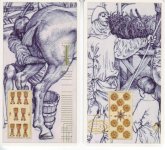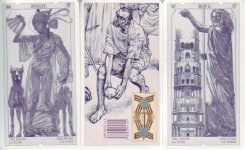Rosanne
8 of Cups / Coupes, 10 of Coins / Pentacles
I would like to talk about two very different cards in this deck, well the images evoke something very different from usual in me.
8 Cups/Coupes:
Coupes is the Suit of Water, spiritual nutrition, birth and life.
The Number 8 : Knowledge-Every doubt can be dispelled even if it leads to new doubts. Learn by finding your limits to your own knowledge.
The servant in this image appears to be milking a stallion. The Artist calls this card simplicity.Even if it is a mare, and she has an udder, it is not a simple job to milk it. It brings to mind the thought "If horse milking can be demonstrated, we can be fairly sure that the horses were domestic." In some decks this card is Saturn in Pisces and so this might show that introspection would be a useful thing. You will learn something from this action of attempting to milk a stallion, a new perspective maybe.
10 Coins/Pentacles
I really like this card. Number 10 is perfection; the suit of Earth and our existence.The artist calls this card Hope.
Well for me it brings in the occult view of inheritance; the foundations of current prosperity, are laid by the previous members of one's family. The inheritance in this card is is the heretical belief of the father about to be burnt at the stake, in this case a sign of the burden the ones family can impose impose. The guard seems to be barring the way of the lad and here lies the Hope I think. Here we have the completion of one cycle and therefore the beginning of a new one. Is this Mercury in Virgo? True knowledge that accumulation of wealth in a material sense should not be the goal. Is this how you might see these two cards?
~Rosanne
I would like to talk about two very different cards in this deck, well the images evoke something very different from usual in me.
8 Cups/Coupes:
Coupes is the Suit of Water, spiritual nutrition, birth and life.
The Number 8 : Knowledge-Every doubt can be dispelled even if it leads to new doubts. Learn by finding your limits to your own knowledge.
The servant in this image appears to be milking a stallion. The Artist calls this card simplicity.Even if it is a mare, and she has an udder, it is not a simple job to milk it. It brings to mind the thought "If horse milking can be demonstrated, we can be fairly sure that the horses were domestic." In some decks this card is Saturn in Pisces and so this might show that introspection would be a useful thing. You will learn something from this action of attempting to milk a stallion, a new perspective maybe.
10 Coins/Pentacles
I really like this card. Number 10 is perfection; the suit of Earth and our existence.The artist calls this card Hope.
Well for me it brings in the occult view of inheritance; the foundations of current prosperity, are laid by the previous members of one's family. The inheritance in this card is is the heretical belief of the father about to be burnt at the stake, in this case a sign of the burden the ones family can impose impose. The guard seems to be barring the way of the lad and here lies the Hope I think. Here we have the completion of one cycle and therefore the beginning of a new one. Is this Mercury in Virgo? True knowledge that accumulation of wealth in a material sense should not be the goal. Is this how you might see these two cards?
~Rosanne



